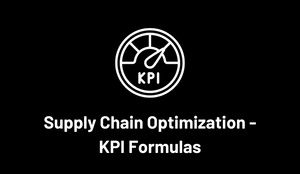Calculating Key Performance Indicators (KPIs) involves using specific formulas or measurements to quantify various aspects of a supply chain's performance. Here's a brief overview of how to calculate some of the common supply chain KPIs:
- Inventory Turnover (ITO):
- Formula: Cost of Goods Sold (COGS) / Average Inventory Value
- Calculate the COGS for a given period (usually annually) and divide it by the average inventory value (the beginning inventory value plus ending inventory value divided by 2) for the same period.
- Inventory Days of Supply:
- Formula: 365 / Inventory Turnover
- Calculate the inventory turnover (ITO) and then divide it into 365 (the number of days in a year).
- Order Fulfillment Rate:
- Formula: (Number of Orders Fulfilled on Time / Total Number of Orders) * 100
- Calculate the percentage of orders that were fulfilled on time.
- Perfect Order Rate:
- Formula: (Number of Perfect Orders / Total Number of Orders) * 100
- Calculate the percentage of orders that meet all criteria for being considered "perfect" (complete, on time, undamaged, and error-free).
- On-Time Delivery (OTD):
- Formula: (Number of Orders Delivered on Time / Total Number of Orders) * 100
- Calculate the percentage of orders that were delivered on time as promised.
- Lead Time:
- Calculate the time elapsed between order placement and order delivery.
- Cost-to-Serve:
- Formula: Total Cost to Serve / Total Revenue
- Calculate the cost to serve (comprising transportation, warehousing, and order processing costs) and divide it by the total revenue generated.
- Transportation Cost per Unit:
- Formula: Total Transportation Cost / Total Units Shipped
- Calculate the total transportation cost and divide it by the total number of units shipped.
- Cash-to-Cash Cycle Time:
- Calculate the time between cash outflows (e.g., purchasing inventory) and cash inflows (e.g., sales revenue).
- Supplier On-Time Delivery (SOTD):
- Formula: (Number of On-Time Deliveries from Supplier / Total Number of Deliveries from Supplier) * 100
- Calculate the percentage of on-time deliveries from suppliers.
- Supplier Lead Time:
- Calculate the time between order placement with a supplier and the receipt of goods.
- Supplier Quality Rating:
- Typically based on assessments and inspections, which include aspects like the quality of goods received, defects, and conformity to specifications.
- Order Cycle Time:
- Calculate the time it takes to process a customer order, from order receipt to shipment.
- Distribution Center (DC) Utilization:
- Evaluate the usage of distribution centers by comparing the actual capacity used to the total available capacity.
- Forecast Accuracy:
- Typically measured by comparing the forecasted demand to actual demand over a specific period, usually expressed as a percentage.
- Backorder Rate:
- Formula: (Number of Backordered Items / Total Number of Ordered Items) * 100
- Calculate the percentage of ordered items that are backordered.
- Return Rate:
- Formula: (Number of Returns / Number of Units Sold) * 100
- Calculate the percentage of units sold that are returned by customers.
- Sustainability Metrics:
- Sustainability KPIs require the collection and analysis of relevant environmental data, such as emissions, energy consumption, and waste reduction, typically measured in units like kilograms, megawatt-hours, or tons.
- Cost of Goods Sold (COGS):
- Calculate the direct costs associated with producing or purchasing the goods sold, including materials, labor, and overhead costs.
- Overall Equipment Effectiveness (OEE):
- OEE is calculated using the formula OEE = Availability x Performance x Quality, where each of these factors is expressed as a percentage.
To calculate these KPIs accurately, it's essential to ensure that the data used in the formulas is consistently collected and maintained. Automation and data management systems can assist in this process, ensuring data accuracy and enabling real-time monitoring of KPIs for supply chain optimization.

